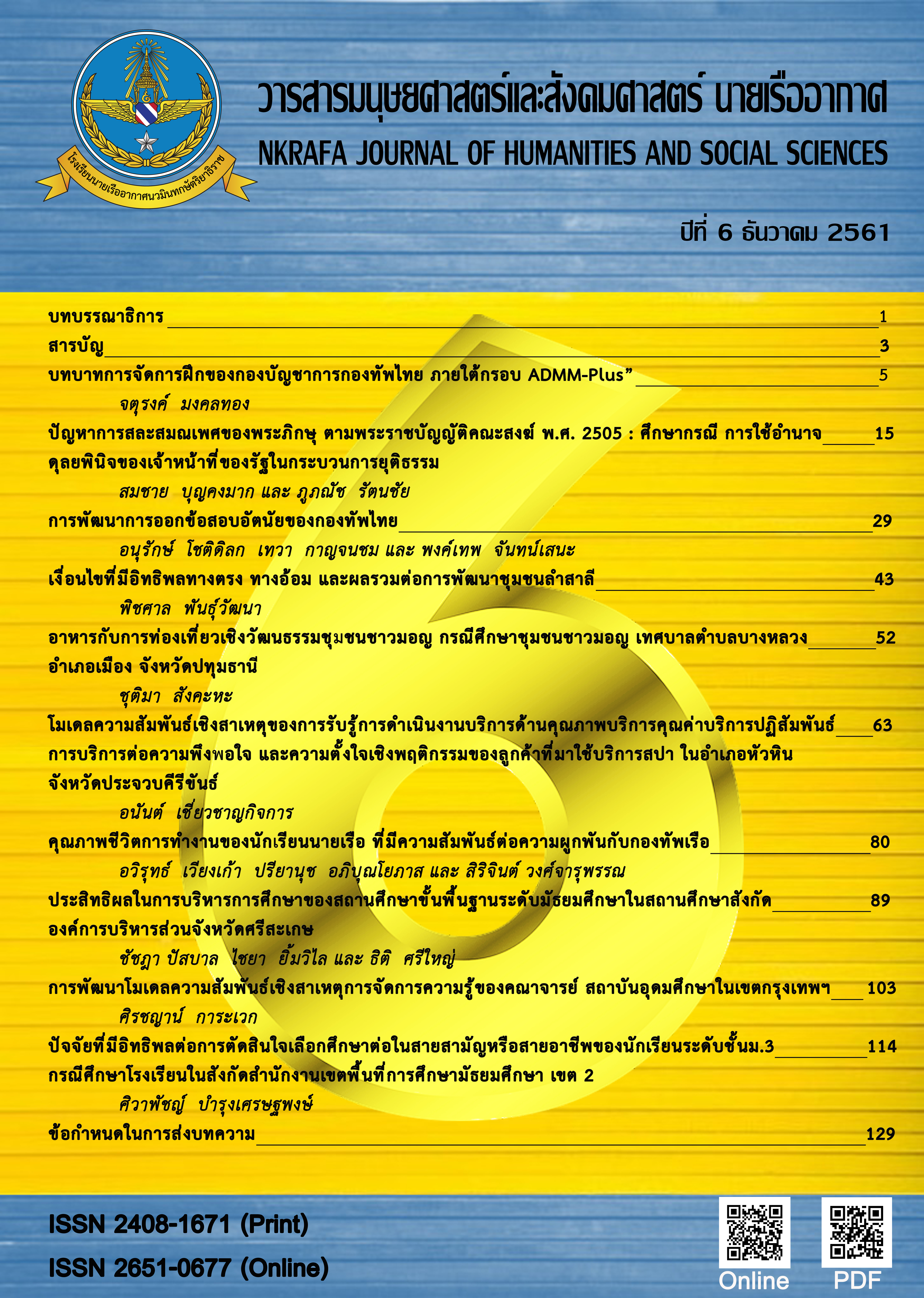Food and Mon Cultural Tourism, Case Study in Mon community, Bang Luang Municipality, Mueang District, Pathum Thani.
Main Article Content
Abstract
The research objective was to demonstrate belief in the importance of food in each tradition to promote cultural tourism in Mon community, Bang Luang municipality, Mueang district, Pathumthani province. The data were obtained from key informants, such as Bang Luang temple’s abbot and assistant abbot, Mayor of Bang Luang subdistrict municipality, chief and deputy chief of Bang Luang municipal cultural center, Pathumthani province cultural office staff, community secondary school teachers. And 9 local wisdoms were obtained by snowball sampling. Observation participation, in-depth semi-structured interview, focus group discussion and group interviews the document was also conducted and related empirical studies. The connection between food and the culture of the Mon is typically demonstrated by four traditions observed at the Bang Lung temple, as well as being generally related to the wider tradition and culture of Buddhism. The main ingredients for the dishes are based on rice and cereal and their belief in each of the food tradition has the meaning of rewarding with prosperity those who are dedicated and who give merit to the deceased ancestors. The first khao thip in the tradition of khao thip making takes place one week before the Mon New Year. The second tradition, which also takes place at New Year April 15th, is known as Mon Songkran and sees celebrants eating khao chae (rice in ice water). Another tradition involves offering a food called krayasarth (cereal bar). Krayasarth making is performed during the 11th lunar month. The last tradition, a honey offering which is observed on the 15th day of the 11th lunar month, involves honey and the preparation of a dish called khao tom luk yon. These traditions, involving the offering of different types of food to monks, go to the heart of Mon culture and can be utilized to actively promote tourism with visitors encouraged to buy the different foods, watching cookery demonstrations, and being taught about the beliefs that underpin these observances. Additionally, another Mon New Year tradition, which could well be used for promotional purposes, is the Swan Parade with its many colorful flags and the bathing rites for images of Buddha and the monks.
Article Details
บทความที่ได้รับการตีพิมพ์เป็นลิขสิทธิ์ของวารสารมนุษยศาสตร์และสังคมศาสตร์ นายเรืออากาศ
ข้อความที่ปรากฎในบทความแต่ละเรื่องในวารสารวิชาการเล่มนี้ เป็นความคิดเห็นส่วนตัวของผู้เขียนแต่ละท่าน ไม่เกี่ยวข้องกับโรงเรียนนายเรืออากาศฯ และคณาจารย์ท่านอื่น ๆในโรงเรียนนายเรืออากาศฯ แต่อย่างใด ความรับผิดชอบขององค์ประกอบทั้งหมดของบทความแต่ละเรื่องเป็นของผู้เขียนแต่ละท่าน หากมีความผิดพลาดใด ๆ ผู้เขียนแต่ละท่านจะรับผิดชอบบทความของตนเองแต่เพียงผู้เดียว
References
[2] วิมลรัตน์ บุญศรีรัตน์, “แนวทางการพัฒนาอาหารเพื่อการท่องเที่ยวในจังหวัดภูเก็ต,” สถาบันบัณฑิตพัฒนบริหารศาสตร์, คณะการจัดการการท่องเที่ยว ศูนย์ภูเก็ต, [Online]. Availble: http://www.tour.nida.ac.th/wp-content/phuket-gastronomy.pdf , 2560.
[3] บัณฑิต อเนกพูนสุข, “เพียงความเคลื่อนไหว,” จุลสารวิชาการการท่องเที่ยว ทีเอที รีวิว, ปีที่ 3 ฉบับที่ 1, หน้า 8-19, 2560.
[4] วุฒิชัย กฤษณะประกรกิจ, “ แนวโน้มท่องเที่ยว,” จุลสารวิชาการการท่องเที่ยว ทีเอที รีวิว, ปีที่ 3, ฉบับที่ 1, หน้า 27-35, 2560.
[5] วีรวัฒน์ วงศ์ศุปไทย, “ปทุมรามัญญธานีเทิดไท้องค์ราชันย์ ไทยรามัญย้อนรำลึก ชนชาติมอญ,” ปทุมธานี: องค์การบริหารส่วนจังหวัดปทุมธานี, 2555.
[6] อรสา เงินฉาย, “การศึกษาสภาพวัฒนธรรมของชุมชนชาวมอญเกาะเกร็ด อำเภอปากเกร็ด จังหวัดนนทบุรี,” ปริญญานิพนธ์วิทยาศาสตรมหาบัณฑิต (ภูมิศาสตร์), มหาวิทยาลัยศรีนครินทรวิโรฒ, 2550.
[7] วงศ์ธีรา สุวรรณิน และคณะ, “การศึกษาศักยภาพการท่องเที่ยวเชิงวัฒนธรรมของวัดในจังหวัดปทุมธานี,” วารสารบัณฑิตศึกษา มหาวิทยาลยัราชภัฏวไลยอลงกรณ์ ในพระบรมราชูปถัมภ์, ปีที่ 8 ฉบับที่ 3, กันยายน-ธันวาคม, หน้า 64-82, 2557.
[8] นิคม บางจริง, “ผลิตภัณฑ์แปรรูปจากข้าวในวิถีชีวิตชาวมอญ อำเภอสามโคก จังหวัดปทุมธานี,” ศิลปศาสตร มหาบัณฑิต (พัฒนาชนบทศึกษา), มหาวิทยาลัยมหิดล, 2553.
[9] วินิธา พานิชย์, “กลยุทธ์การจัดการท่องเที่ยวเชิงวัฒนธรรมบนแนวคิดเศรษฐกิจสร้างสรรค์ของจังหวัดสกลนคร,” ขอนแก่น : มหาวิทยาลัยขอนแก่น, 2557.
[10] Hall, C.M. & Mitchell, R., “Food tourism, in niche tourism: contemporary issues, trends and cases, (ed),” M. Novelli, Butterworth Heinemann, pp.73-88, 2005.
[11] ญาณภา บุญประกอบ และคณะ, “ศึกษาเรื่องอาหารพื้นถิ่นกับกลไกในการส่งเสริมการท่องเที่ยวเชิงสร้างสรรค์: กรณีศึกษา กลุ่มชาติพันธุ์ลาวครั่ง จังหวัดชัยนาท,” วารสารวิทยาลัยดุสิตธานี ปีที่ 11 ฉบับพิเศษ,หน้า 93-107, พฤษภาคม, 2560.
[12] พลาดิศัย สิทธธัญกิจ, “วัฒนธรรมข้าวภูมิเกษตรในประชาคมอาเซียน,” แนวหน้า, 25 พฤษภาคม 2557.
[13] สุดใจ แก้วแวว, “การศึกษาเปรียบเทียบประเพณีสงกรานต์ของชุมชนมอญ ตำบลเจ็ดริ้ว อำเภอบ้านแพ้ว จังหวัดสมุทรสาคร กับชุมชนมอญ ตำบลเกาะเกร็ด อำเภอปากเกร็ด จังหวัดนนทบุรี,” สาขาไทยคดีศึกษา, มหาวิทยาลัยสุโขทัยธรรมาธิราช, 2551.


